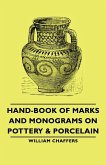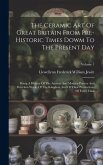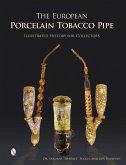Originally published in 1862. The Collector's Hand-Book OF MARKS AND MONOGRAMS ON POTTERY AND PORCELAIN by WILLIAM CHAFFERS. Of the Renaissance and Modern Periods SELECTED FROM HIS LARGER WORK ( EIGHTH EDITION). EDITOR'S PREFACE TO THE NEW EDITION: THIS New Edition of Chaffers' Hand-book is now published in a more complete form than the previous issues,, and should be of greater service to the collector, for, in addition to some 500 marks which have been contributed by the Editor, there are a great many which the late Mr. Chaffers had inserted in his Seventh Edition of the large book, but which had not been included in his previous edition of the Hand-book. The present edition is, therefore, a complete excerpt or resume as regards the marks of the original work, entitled MARKS AND MONOGRAMS ON POTTERY AND PORCELAIN, by W. Chaffers, the last or eighth edition of which was revised by the present editor and published in 1897. No material change has been made in the arrangement of the work, which follows that of the larger book re ferred to above. The sixc is handy for the collector's pocket j and to maintain this desirable end, some of the larger marks have been, reduced iru. scale and a lighter paper used, so as not to materially increase the bulk. The following very slight historical outline sketch has been added by the Editor, which it is hoped will be of service to the collector. The subject of the references in the following pages may be roughly divided into two classes Pottery and VI Porcelain. Pottery includes stoneware and enamelled or glazed earthenware ; porcelain, that more vitreous and transparent composition of china clay and petuntse or ground flint, which is more akin to glass. For the purposes of this Hand book it is unnecessary to explain in further detail the differences in composition and texture of the two classes of Ceramics, but speaking generally, pottery breaks with a rough surface of its frac tured parts, as would an ordinary piece of terra-cotta, while porcelain breaks with smooth surfaces, similar to glass. To the Pottery class belong all those faMtjues of enamelled earthenware called MAIOI. ICA, FAYKNCK, or DELFT, these being the Italian, French, and Dutch subdivisions respectively, although the terms have become intermixed, and casually applied to all classes of faience. The most famous of the Italian maiolica, first made in the later part of the fifteenth century, under the personal patronage and encouragement of the dukes or petty sovereigns of the little states and duchies into which Italy was then divided, are those of Urbino, Gubbio, Castel Durantc, Pcsaro, Faenza, and Caflagiolo, with many others, the marks of which occupy the first fifty pages of the Hand-book. Of the individual artists who deco rated the ware, none is so celebrated as Maestro Giorgio Andreoli, more commonly known as Maestro Giorgio, who worked at Gubbio. Several of the characteristic and diversified signatures of this famous artist are given for the collector's reference, but as genuine specimens of this master have been so thoroughly searched for, and ab sorbed into museums and well-known private collections, the unskilled collector should be very sceptical








